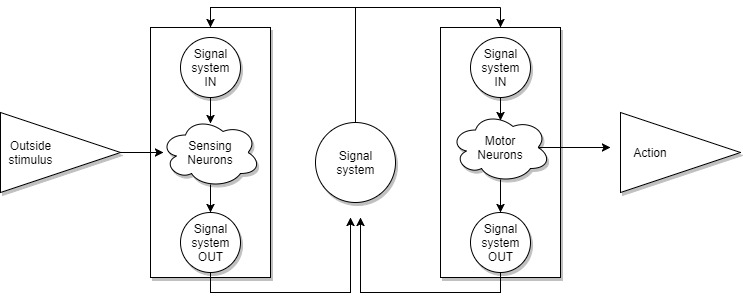Theoretical Neurobiology. Part two. Singularity?

In the first part, we came to the conclusion that the brain has a set of triggers and a signal system for transmitting signals between remote sets. Upon receipt of external stimuli, the set of stimuli corresponding to the stimuli is activated, which leads to the production of an appropriate set of hormones. Hormones irritate other sets of triggers that have a similar set of hormones for activation. Which generates a chain reaction. That is, our consciousness is nothing more than the search for equilibrium between the two systems, the trigger system and the signal system. At the same time there are external stimuli that bring the system out of balance. It can be assumed that such a system will never reach equilibrium.
Let's try to consider it in more detail.
English version, more formalized, here .
Suppose that one neuron can memorize and respond to one particular signal. That is, one signal is at the input and, if the neuron is free, it “remembers” it and then reacts only to this signal. If this signal is not updated for some time, then the neuron returns to its original state. In our theory, we will not need a division of memory into long-term and short-term memory. We also will not resort to the services of an external observer who forms the logic, but first things first.
')
We have the hypothalamus as a “factory” for the signal system. According to studies, the hypothalamus is physically connected with almost all parts of the nervous system. In relation to our tasks, we will imagine that we have sets of neurons that are physically connected to the nerve endings of our signal system in order to place an order for the production of the necessary signals. And a set of neurons, each of which responds to one of one hundred signals from the signaling system. And neurons that respond to external sensors.
To prove the theory, we need to detect sets of neurons that respond to a wide range of hormones. And it is quite difficult on the existing level of technology, because the number of such neurons is rather small, relative to the total mass. We can assume that the number of neurons reacting to a particular hormone will be calculated by several thousand, in a total mass of about 100 billion.
Let's try to introduce ...
In the beginning was the WORD. For us, no matter what the word was. It is important that any word is a well-established pattern of sounds describing an object, event, or state. A few words together form a new pattern for a more detailed description. That is, within the framework of the theory, the relationship between the patterns will be the same at any level of abstraction. We can also assume that the patterns will be grouped close relative to each other.
Since it will be somewhat difficult to consider and understand the system through binary examples, this will most clearly be demonstrated by the example of structured information. To do this, we approach any meaningful text. Let's accept a conditional neuron equal to one word.
Here you can see the first visual model.

As you can see, one set can consist of several other sets, which can be partially or entirely belong to other sets. Different colors represent different sets. It resembles a Russian doll. But at the same time, some parts of the dolls can simultaneously be part of other dolls and the level of investment can reach quite significant values.
Consider each set of neurons as a set. And the whole system as the relationship of these sets with each other. To describe such a system, we are best suited graph. We can say that the graph is exactly the optimal structure that allows you to organize the entire mass of neurons.
The minimum set will consist of neurons that recognize hormones, neurons connected to the hypothalamus, ordering hormones, and sensory neurons that process information from external, relative to the brain, sensors.
The set for motor neurons will look exactly the same, only instead of processing sensors, it will issue commands to the body for execution.
That is, in the case of sensory sets of neurons, the incoming stimuli to the higher neurons are combined, with the motor set the unfolding takes place from several neurons to the downstream neurons, which will directly produce the action.

Assuming that in the message through the signaling network we can enable or disable the command to implement the action. For example, first learn to read out loud and only after some time it turns out to learn how to read without saying a word. If there is no message on the implementation team, an internal dialogue between the sets occurs. It is also necessary to constantly remember that the patterns within each of the areas have a physical connection with other patterns. And under certain conditions a generalization of several patterns can occur.
Let's look at the most common example of how learning takes place.

At the first stage, the signals from the sensors are divided into minimally known sets consisting of sensory neurons. And these sets produce their corresponding markers. In the second stage, the markers reach the motor neurons and annoy them. And if the stimuli do not belong to the same group, then this breaks the balance and causes the system to create a new set of these stimuli and assign it a marker. A new marker will also be assigned to a similar group of sensory neurons. Within the framework of this article, we will not consider this process completely, there are a lot of nuances in it. For example, the original markers appeared in sets of sensory neurons at the time of “initialization”, I hope you remember how babies are initialized. You can also notice that any learning is stressful.
It is worth noting that starting this project, we did not have the task to create an exact copy of the biological processes occurring in the brain. We assumed possible evolutionary stages and, on the basis of them, tried to create a structure capable of processing a lot of sensors and implementing control of a large number of muscles. During the development process, we created 6 versions of the program code, implemented the possible structure of the sensory part of the neurons. Each version introduced additional data and refined the picture. It can be said that the receiving model exhibits the same symptoms as the living brain.
What we have done is very similar to the process that is used to decipher forgotten languages, when in the “text” they find and match the same characters or words, building meaning in context.

In this example, a graph of two words, one of which is written with an error. If we continue learning this model, the word with the correct spelling will be used in other sets more often than with the wrong spelling. Physically, a neuron combining a set with the correct spelling will be used more often. And, most likely, it will take precedence over the neuron, which combines the set with the wrong spelling. With age, frequently used kits take on higher priority due to the frequency of their use in other kits. Presumably, this is exactly what experience and character look like. When your reaction to a certain situation is pretty straightforward.
If what is heard or seen uses a significant part of the already familiar pattern, then we can assume the spelling is correct or the general sense.

Approximately the same is the preservation of the context during the conversation. Since the hormones of the signal system are not immediately removed from the blood, they continue to irritate the same patterns. And the word that has several meanings, continues to belong to the previously activated set.
There is also one interesting point that we encountered in the process of computer modeling. Some kits to describe your own content contain several copies of other kits. Which leads to the creation of an exact copy of an existing set. And the process of creating copies happens all the time. We called this process “deja vu”, and in our case it led to an indexing problem in the database that we used at that stage.
It is worth noting that the set should always lead to some kind of action. At the same time, this action does not always imply any real action in the physical world. There are sets that switch the implementation of any action into virtuality. But the completeness of the set and realizes our interest and desire to achieve the goal and return balance.
As for the process that we call consciousness, we can assume that this is largely determined by a process that takes place at least between two sets of neurons using a signal network and resembles an internal dialogue.
It is also worth noting that the signal system itself is a bit more complicated than just a message passing mechanism. And figuratively it can be represented as a kind of stencil on an array of patterns.
The “touch structure” that the implemented part of the model creates can be used as a self-sufficient expert system. You can imagine it as a forest, where trees share some leaves and even pieces of trunks and branches. That is, having “grown” a new tree, you can very easily see where it intersects with the experience that already exists and what this experience led to in other cases / trees.
At the moment, based on the experience with previous versions that implemented only the sensory structure, we are assembling the full version of the system. The new version will implement the full algorithm of the model, including self-study. This system will recognize the speaker and learn how to synthesize words and phrases from the minimum tones available to the DAC.
Source: https://habr.com/ru/post/370973/
All Articles